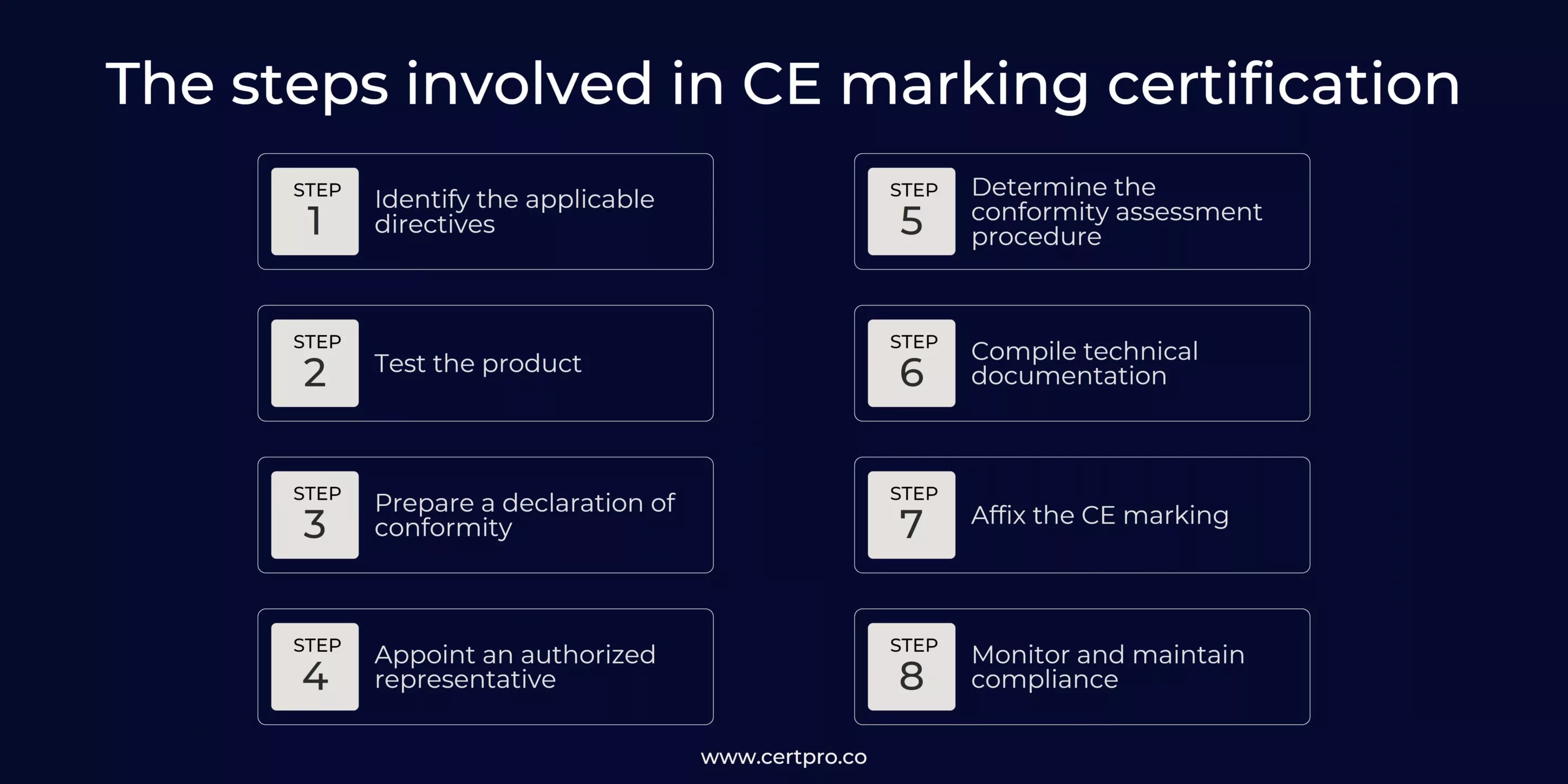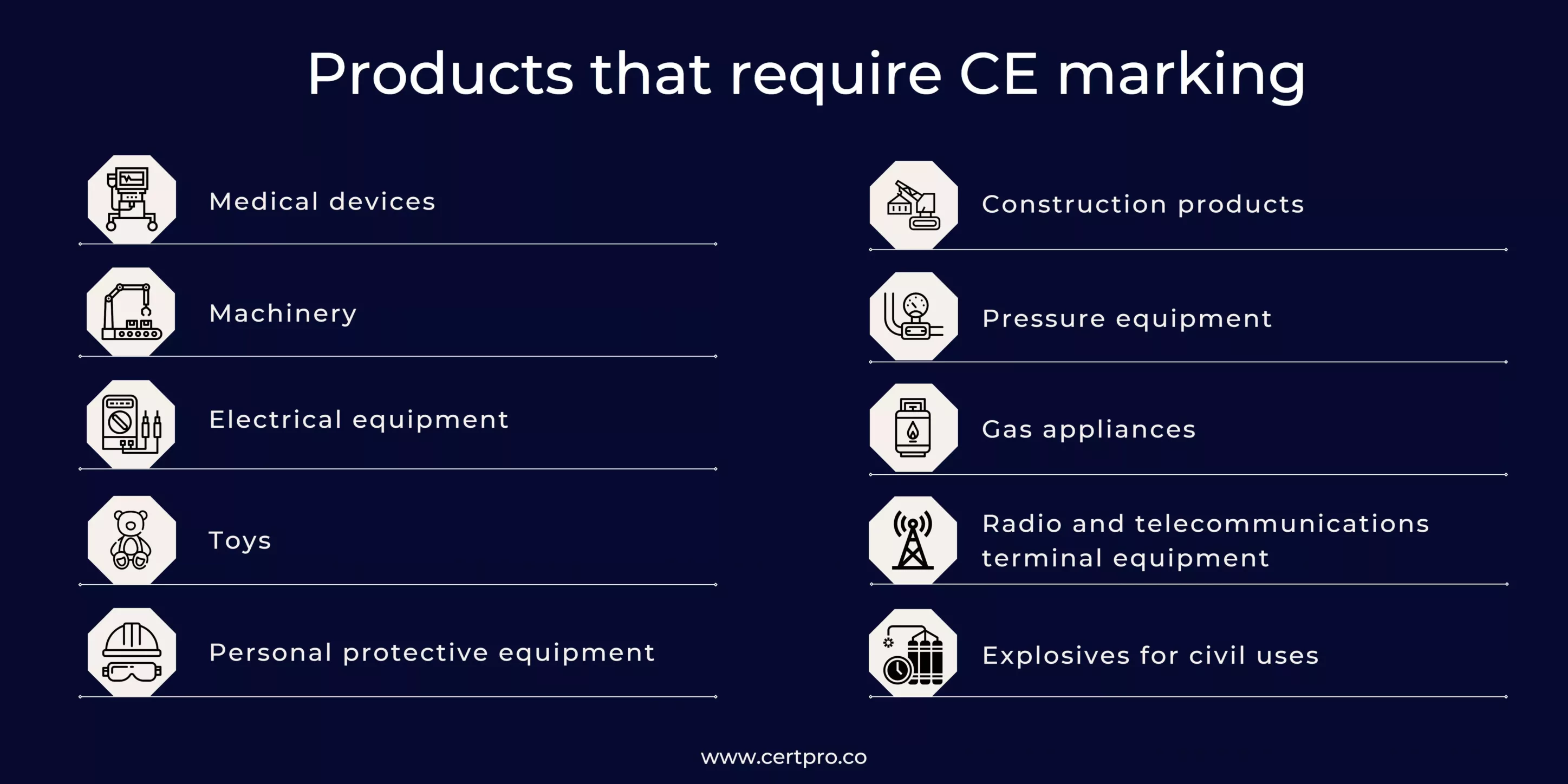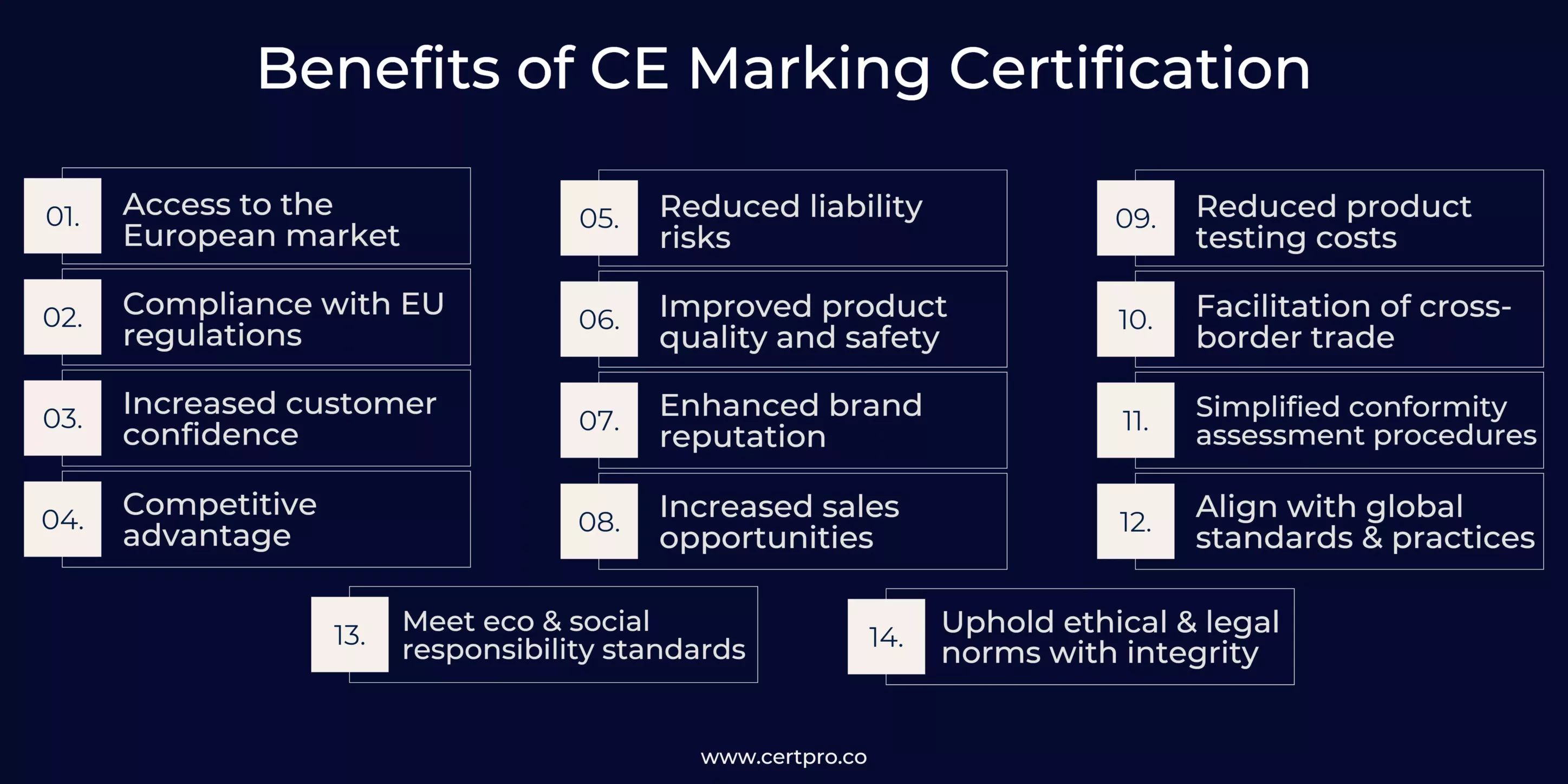ce MARK
Conformitè Europëenne
CE marking is a certification mark that indicates a product meets the health, safety, and environmental protection requirements of the European Union (EU) and is required for products sold in the European Economic Area (EEA).
The CE mark stands for “Conformité Européene,” which translates to “European Conformity.” It is a symbol that indicates a product complies with all relevant European Union (EU) regulations and directives related to health, safety, and environmental protection. The CE mark is a stylized letter “CE”, which must be affixed to a product or its packaging in a visible, legible, and indelible manner. The letters “CE” must be in the same proportions, and the mark must be at least 5 millimeters in height, unless the size of the product makes this impossible, in which case the CE mark must be proportionate to the size of the product. The CE mark must also contain information, including the name and address of the manufacturer, the product identification number, and the year of affixing.

Certification and Conformity Assessment Services by CertPro for CE Marking
At CertPro, we recognize the significance of achieving CE marking for your products and understand the complexities involved in the process. Our dedicated team of experts is here to provide comprehensive support to organizations seeking CE mark certification. We will guide you through the entire certification journey, ensuring that your products comply with the relevant EU directives and regulations. From initial assessment to documentation preparation and conformity evaluation, we are committed to helping you navigate the intricacies of CE marking.
Why Choose CertPro for CE Marking Certification?
At CertPro, we understand the importance of selecting the right partner for your CE marking certification needs. Here are several key factors that set us apart, along with the advantages you can expect when choosing CertPro:
| Factors | CertPro Advantage |
|---|---|
| Time to Certification | 4x faster than traditional approaches |
| Price | Competitive rates with flexible options |
| Process | Streamlined and efficient methodology |
| Expertise | 10+ years of industry experience |
CertPro’s Cost-Effective Approach to CE Marking Certification
At CertPro, we understand that obtaining CE marking certification involves careful consideration of costs and budgetary constraints. We are committed to providing a cost-effective solution that ensures your organization achieves compliance without compromising on quality. Our tailored pricing structure takes into account various factors that influence the overall expenses, making it easier for you to understand and plan your certification journey. Here’s an overview of our transparent pricing tiers:
| Milestone | Timeline | Cost (approx.) |
| Declaration of Conformity | 1 week | 1000 USD |
| Conformity Assessment | 2 weeks | 1500 USD |
| Certification | 1 week | 1500 USD |
| Total | 4 weeks | 4000 USD |
Understanding the Fundamentals of CE Marking
CE marking is a certification mark that indicates that a product meets the health, safety, and environmental protection requirements of the European Union (EU) and is necessary for products sold in the European Economic Area (EEA). When a product has the CE mark, it meets the requirements of the applicable EU directives and regulations and is eligible for unrestricted trade within the EEA, regardless of its country of origin.
The EU directives or regulations applicable to a product depend on its type and intended use. For example, the Restriction of Hazardous Substances Directive (RoHS) restricts the use of certain hazardous substances in electrical and electronic equipment, while the Waste Electrical and Electronic Equipment Directive (WEEE) sets requirements for the collection, treatment, recycling, and disposal of such equipment.
Compliance with EU directives or regulations is necessary for obtaining CE marking. This involves assessing the product’s conformity with the applicable requirements, preparing technical documentation, and affixing the CE mark to the product or its packaging.
The steps involved in CE marking certification
The steps involved in CE marking are as follows:
- Identify the applicable directives: Determine which EU directives or regulations apply to the product. Find the information in the EU’s official journal or ask a notified body for advice.
- Determine the conformity assessment procedure: Determine the appropriate conformity assessment procedure for the product. Consult EU directives or regulations or seek advice from a notified body.
- Test the product: Conduct testing and analysis to ensure that the product meets the relevant EU requirements. Manufacturers or third-party testing labs can do it.
- Compile technical documentation: Compile technical documentation that demonstrates the product’s compliance with the relevant EU directives or regulations. This documentation should include design specifications, test results, and manufacturing processes.
- Prepare a declaration of conformity: Prepare a declaration of conformity that confirms the product’s compliance with the relevant EU directives or regulations. The manufacturer or authorized representative should sign this.
- Affix the CE marking: Affix the CE marking to the product or its packaging. The CE marking should be visible, legible, and indelible.
- Appoint an authorized representative: If a manufacturer is not based in the EU, they should appoint an authorized representative located within the EU.
- Monitor and maintain compliance: Monitor and maintain compliance with the relevant EU directives or regulations. And this includes keeping up to date with any changes in the requirements, conducting periodic testing, and responding to any complaints or incidents related to the product.
Overall, CE marking is a complex process that requires careful planning and attention to detail. Manufacturers should seek expert advice and guidance to ensure their products comply with all relevant EU requirements.

Importance and Mandate of CE Marking
Importance of CE marking
- CE marking is important for several reasons, such as:
1. Legal Requirement: Many products sold in the European Economic Area (EEA) must bear the CE mark. Non-compliance can lead to legal consequences such as fines, seizure of products, and even criminal liability.
2. Health and Safety: CE marking ensures that products sold in the EEA and Switzerland meet the relevant health, safety, and environmental protection requirements, thereby protecting consumers, workers, and the environment.
3. Facilitating Trade: CE marking helps to facilitate trade within the EU by establishing common technical and safety standards that must be met to sell products in the EEA.
4. Market Access: Many non-EU nations recognize CE marking as a standard for product quality and safety and this can provide manufacturers with increased market access and export opportunities.
5. Competitive Advantage: CE marking can provide manufacturers with a competitive advantage by demonstrating that their products meet the necessary standards and are safe for use, which can increase consumer trust and confidence in the product.
- The mandate of CE marking
The mandate of CE marking is to ensure that products sold within the European Economic Area (EEA) meet the essential health, safety, and environmental protection standards required by EU law. The CE marking is mandatory for products manufactured in the EEA as well as for products imported from outside the EEA. The EU wants to safeguard consumers from potential harm from unsafe or non-compliant products by requiring CE marking. The CE marking certifies that the product’s manufacturer or importer has taken the necessary precautions to ensure compliance with the relevant EU directives and regulations and that non-compliance will result in enforcement action.
Requirements for CE marking certification, manufacturing, products, and countries
The requirements for CE certification vary depending on the product category and the applicable European Union (EU) directive or regulation. In general, CE certification requires manufacturers to follow a conformity assessment procedure that demonstrates their product meets the relevant EU requirements.
The conformity assessment procedure typically involves the following steps:
1. Identification of the applicable EU directives or regulations that apply to the product
2. Determination of the conformity assessment procedure that applies to the product, which may involve self-certification, type examination, or full quality assurance.
3. Evaluation of the product to ensure it meets the essential health, safety, and environmental protection standards specified by the relevant EU directive or regulation
4. Creation of a technical file that includes all relevant documentation related to the product, such as test reports, drawings, and instructions for use.
5. Issuance of a Declaration of Conformity that declares the product meets the essential requirements of the applicable EU directive or regulation
6. Affixing the CE marking to the product to indicate compliance with the relevant EU requirements.
It is significant to note that the requirements for CE certification can be intricate and may entail the involvement of a notified body, which is a third-party organization that has received permission from the relevant EU member state to carry out conformity assessment procedures.
The primary requirements for CE certification are ensuring that goods put on the market within the European Economic Area (EEA) adhere to the necessary health, safety, and environmental protection standards and safeguarding consumers from potential harm from unsafe or non-compliant goods.
Manufacturers that require CE marking
CE marking places certain obligations on manufacturers, importers, distributors, and EU customers. Manufacturers are responsible for ensuring that their products meet the relevant requirements and must affix the CE mark to their products. Importers must ensure that the products they import comply with EU requirements and that the CE mark is affixed. Distributors must verify that the CE mark is affixed and that the required documentation is available. EU customers must check that the products they buy bear the CE mark and that the necessary documentation is included. All parties involved in the supply chain must cooperate to ensure compliance with CE marking requirements.
Products that require CE marking
The products that need CE marking are those that fall under the scope of the relevant EU directives, regulations, and standards. This category includes some products, including:

It is the responsibility of the manufacturer or importer to determine whether their product falls under the scope of the relevant EU directives, regulations, or standards and to ensure that the necessary conformity assessment procedures have been completed and the CE marking affixed before the product is made available for use or sale in the EEA.
Countries that require CE marking
CE marking is required for products sold within the EEA, which includes the 27 member states of the EU as well as Norway, Iceland, and Liechtenstein. However, some countries outside the EEA, such as Switzerland and Turkey, may also require products to bear the CE marking if they fall under the scope of the relevant EU directives, regulations, or standards. These countries are:
Austria, Belgium, Bulgaria, Croatia, Cyprus, Czech Republic, Denmark, Estonia, Finland, France, Germany, Greece, Hungary, Ireland, Italy, Latvia, Lithuania, Luxembourg, Malta, Netherlands, Poland, Portugal, Romania, Slovakia, Slovenia, Spain, and Sweden.
Any product sold within these countries that falls under the scope of the relevant EU directives, regulations, or standards must bear the CE marking and meet the required conformity assessment procedures.
After the United Kingdom’s exit from the European Union, a new UK product marking, known as the UKCA (UK Conformity Assessed) marking, has been introduced for goods placed on the market in Great Britain (England, Scotland, and Wales). However, the CE marking continues to be recognized in Northern Ireland and the EU. This means that products sold in Northern Ireland or the EU must continue to bear the CE marking, and products sold in Great Britain must bear the UKCA marking.
Benefits of CE Marking Certification
CE marking certification indicates that a product meets the health, safety, and environmental protection standards required for sale within the European Economic Area (EEA). Benefits include increased market access, customer confidence, and legal compliance, leading to improved sales, reduced liability, and enhanced brand reputation. The benefits of CE marking certification include:

Steps involved in affixing the CE marking
To affix the CE marking to your product, follow these steps:
- Determine the appropriate location for the CE marking on the product or its packaging. It should be affixed in a visible, legible, and indelible manner.
- Check the size of the CE marking against the minimum dimensions required by the relevant EU directive or regulation.
- Ensure that the CE marking is affixed only after the product has undergone the necessary conformity assessment procedures and meets the relevant EU requirements.
- Affix the CE marking using a permanent method, such as engraving, embossing, or silk-screen printing.
- Accompany the CE marking with the other required information, such as the product identification number and the name and address of the manufacturer.
- Ensure that the CE marking and accompanying information are easily accessible to authorities, customers, and end-users.
- Be prepared to provide a Declaration of Conformity and technical documentation upon request from authorities or customers.
Remember to keep all technical documentation and records of conformity assessment procedures for a minimum of 10 years. Additionally, continuously monitor compliance with the applicable EU requirements and update the product as necessary to maintain conformity.
The Cost of Obtaining CE Marking Certification
The cost of obtaining CE Marking certification can vary widely depending on various factors, such as the product category, the applicable European Union (EU) directive or regulation, the complexity of the conformity assessment procedure, and the involvement of a notified body.
Some of the costs associated with obtaining CE marking certification may include:
- Testing costs: Depending on the product category, testing costs may be required to ensure compliance with the essential health, safety, and environmental protection standards specified by the relevant EU directive or regulation.
- Technical documentation costs: The creation of technical files and other documentation related to the product can also incur costs.
- Notified body fees: Notified bodies may charge fees for their services if their involvement is necessary for the conformity assessment procedure.
- Travel costs: Travel costs may also be incurred if the manufacturer or importer needs to conduct testing or collaborate with a notified body.
Overall, the cost of obtaining CE marking certification can vary widely and can be a significant investment for manufacturers or importers. However, the benefits of CE Marking certification, such as increased market access, compliance with EU regulations, and improved product quality and safety, can outweigh the costs in the long run.
Validity of CE Mark Certification
The CE mark does not have an expiration date, and once a product has been certified and the CE marking has been affixed, it remains valid as long as the product continues to meet the relevant EU directives and regulations. However, it is the responsibility of the manufacturer to ensure ongoing compliance through regular product monitoring and assessment. If any changes are made to the product or its manufacturing process that could affect its conformity, a reassessment may be necessary. Additionally, if new directives or regulations are introduced, the product may need to be reevaluated for compliance. Overall, the CE mark remains valid as long as the product maintains conformity with the applicable requirements.
Simplify Your CE Marking Certification Process with CertPro’s Expertise
CE marking is a certification process that signifies the conformity of a product with EU regulations. CertPro is a global company that specializes in compliance auditing, consulting, and certification services to help businesses navigate through the CE marking certification process. Their expert team of auditors and consultants is well-versed in the latest technological developments in compliance auditing and uses industry best practices to expedite projects. CertPro provides turnkey solutions for businesses’ compliance needs while keeping timelines and budgets in mind. Their expertise helps businesses achieve CE marking certification and ensures that they meet all requirements. CertPro’s commitment to delivering quality and efficient services makes them a trusted partner for businesses seeking CE marking certification.
FAQ’s
What is "CE marking self-certification"?
CE marking self-certification means that the manufacturer of a product takes responsibility for ensuring that the product complies with the relevant EU directives and regulations. The manufacturer conducts the necessary conformity assessment procedures and prepares the technical documentation and Declaration of Conformity without involvement from a third-party certifying body.
What is the consequence of non-compliance with CE marking?
Non-compliance with CE marking has consequences for manufacturers, importers, and distributors. They can face legal penalties such as fines, product recalls, or even bans on selling their products in the European market. In addition, non-compliant products can pose a risk to consumers’ health and safety, potentially resulting in injuries or losses, as well as damaging the reputation and trustworthiness of the company. Therefore, businesses must ensure that the products meet all applicable EU requirements and bear the CE marking before placing them on the market.
Can a product be imported from outside the EEA without CE marking?
No, a product cannot be imported from outside the European Economic Area (EEA) without CE marking if it falls under the scope of the relevant EU directives and regulations. CE marking is mandatory for products covered by these regulations, and it indicates that the product conforms to the applicable EU health, safety, and environmental protection requirements. Customs authorities may detain or seize products without the CE marking, and the importer may be subject to legal sanctions.
What is the role of notified bodies in CE marking?
For some products, notified bodies are independent organizations that EU member states have designated to carry out conformity assessments and offer certification services. Their role is to evaluate and verify the conformity of products with the applicable EU requirements and also give technical support and guidance to manufacturers and importers.
Do all products require third-party testing for CE marking?
No, not all products require third-party testing for CE marking. The need for third-party testing depends on the specific directives and regulations applicable to the product. Some products allow manufacturers to self-certify their conformity without involving a third-party testing body, while others may require the mandatory involvement of a notified body for testing and certification.
HOW DOES THE NIST CYBERSECURITY FRAMEWORK FUNCTION, AND WHY IS IT IMPORTANT?
Emerging cyber threats make cybersecurity an essential consideration for organizations handling and managing data. In this regard, the NIST cybersecurity framework applies to improving your cybersecurity program. It is a set of guidelines that helps improve your...
UNDERSTANDING ISO 42001: A GUIDE FOR RESPONSIBLE AI MANAGEMENT SYSTEMS
The invention of artificial intelligence (AI) has changed the operational processes of many industries. However, the rapid growth of technology increases ethical, security, and privacy-related concerns. Therefore, the International Organization for Standardization...
EUROPEAN UNION’S ARTIFICIAL INTELLIGENCE ACT: HOW THIS GROUNDBREAKING LAW AFFECTS YOUR BUSINESS
Nowadays, Artificial Intelligence (AI) is transforming our lives exceptionally well. AI is now streamlining healthcare services, providing virtual assistance, and fulfilling queries. Technologies have boons and curses. Similarly, AI creates many concerns about...



